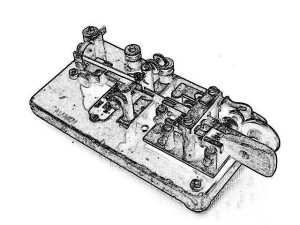 On October 29, 1912, Horace G. Martin was issued U.S. Patent 1,042,457, for an Electronic Telegraph Apparatus. The patent drawing shows a key that was very different from the Original model. The key in the drawing has a frame assembled from two posts with a crossbar on top, rather than cast. The frame and contact posts are mounted on a rectangular platform, and the left and right stop screws are mounted in a U-shaped assembly.
On October 29, 1912, Horace G. Martin was issued U.S. Patent 1,042,457, for an Electronic Telegraph Apparatus. The patent drawing shows a key that was very different from the Original model. The key in the drawing has a frame assembled from two posts with a crossbar on top, rather than cast. The frame and contact posts are mounted on a rectangular platform, and the left and right stop screws are mounted in a U-shaped assembly.
Collectors were aware of Martin’s patent, because it was one of those stamped on Vibroplex nameplates for many years. However, no Vibroplex with the configuration on the patent had ever been found. No advertisements with the key offered for sale had been found. Nobody knew whether or not Martin ever built such a key.
In 2004, almost 90 years after the patent was issued, Martin (DK4XL) spotted a key that looked somewhat like the one in the patent drawing in a blurry photo on an online auction site, and I was able to acquire it. Although the stop screws turned out to be mounted on two posts rather than a single U-shaped piece, it was the “key that never was”, and has been named the “Patent 457” model.
But a question still remained – was it a prototype that was never sold, or were multiple units made and sold? John Casale (K2NI), who writes the “Key and Telegraph” column for the Antique Wireless Association (AWA) Jounal, did some careful research and answered that question. Yes, perhaps as many as 100 were made and sold, based on testimony Horace Martin gave under oath in a patent infringement suit filed by Vibroplex against the J.H. Bunnell Co. Bunnell was selling their own model of semi-automatic key, called the “Gold Bug”.
At the trial, Bunnell’s lawyer asked Martin “About how many of those machines were put out into actual service?”, and he replied “I should say 100”. Martin was motivated to come up with the highest number he could, but it’s clear that enough units were made and sold for it to be considered a separate model.
Vibroplex started selling the Model X soon after, and it became a good seller for the company. It uses the same assembled frame mounted on a small platform, and a very similar lever assembly. If you don’t look too closely you could confuse the two. If you’re a collector, take a close look — you might find another example of the “key that never was”.
